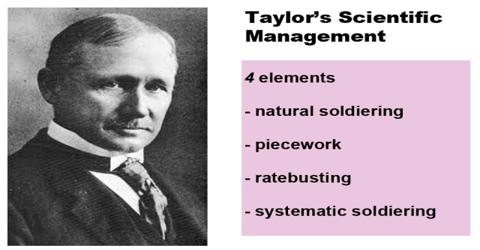Taylor’s Scientific Management
Scientific management refers to an important stream of one of the earlier schools of thought of management referred to as the ‘Classical’ school. The other two streams belonging to the classical school are Fayol’s Administrative Theory and Max Weber’s Bureaucracy.
Fredrick Winslow Taylor (March 20,1856 – March 21, 1915) was an American mechanical engineer who sought to improve industrial efficiency. In 1874, he became an apprentice mechanist, learning factory conditions at the grass roots level. He is known for the coinage of the term ‘Scientific Management’ in his article ‘The Principles of Scientific Management’ published in 1911.
Taylor’s method consisted of testing the completion of various tasks to determine the optimal amount of work that could be accomplished within a certain time period. Taylor’s management theory asserts that organizations should identify the best way to do a job, train workers to handle each element in a pre-determined manner and set up an equitable system of rewards for improved productivity.
Some developments that resulted from the Taylor theory of management are these:
- Significantly improved productivity;
- Increased employee incentive;
- Widespread improvements in quality control;
- Better personnel practices; and
- Greater cooperation between management and workers with a consistent application of Taylor s theory of management.
Taylor thought that by scientifically analyzing work, it would be possible to find ‘one best way’ to do it. He is most remembered for his time and motion studies. He would break a job into its component parts and measure each to the second. Taylor believed that contemporary management was amateurish and should be studied as a discipline. He also wanted that workers should cooperate with the management and thus there would be no need of trade unions. The best results would come from the partnership between a trained and qualified management and a cooperative and innovative workforce.
















